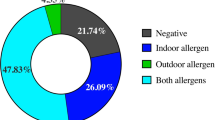Abstract
The results of intradermal testing with three commercial flea antigens and a serological test for IgE antibodies to flea antigens were compared with live flea challenge in cats. Eight control cats with no prior flea exposure had negative serological test and flea challenge results. By contrast, 17 out of 27 cats with previous flea exposure showed immediate reactivity to flea challenge; reactivity at 6, 24 and 48 h after flea exposure was noted in 12, 16 and 21 cats, respectively. Seventeen of these cats had positive serological test results. Seven cats showed immediate intradermal test reactions to the ARTU allergen, six reacted to the Biophady allergen, and six reacted to the Greer allergen. Intradermal test reactivity was less frequent at the other time points. Using the results of the flea challenge as the ‘gold standard’ for the presence or absence of sensitisation to fleas, the sensitivity and specificity of the serological test was 0.88 and 0.77, respectively. Sensitivities of the intradermal tests at the four time points ranged from 0 to 0.33, whereas the specificities ranged from 0.78 to 1.0. Live flea challenge is better able to detect cats with hypersensitivity to fleas than either intradermal or serological testing.

Similar content being viewed by others
References
Colombini S, Hodgin EC, Foil CS, Hosgood G, Foil LD (2001) Induction of feline flea allergy dermatitis and the incidence and histopathological characteristics of concurrent indolent lip ulcers. Vet Dermatol 12:155–161
Foster AP, O’Dair H (1993) Allergy testing for skin disease in the cat: in vivo vs in vitro tests. Vet Dermatol 4:111–115
Frank GR, Hunter SW, Stiegler GL, Wallenfles LJ, Kwochka KW (1998) Salivary allergens of Ctenocephalides felis: collection, purification and evaluation by intradermal skin testing in dogs. In: Kwochka KW, Willemse T, von Tscharner C, (eds) Advances in veterinary dermatology, vol. 3. Butterworth Heinemann, Oxford, pp 201–212
Gerstman BB, Cappucci DT (1986) Evaluating the reliability of diagnostic test results. J Am Vet Med Assoc 188:248–251
Halliwell REW, Schemmer KR (1987) The role of basophils in the immunopathogenesis of hypersensitivity to fleas (Ctenocephalides felis) in dogs. Vet Immunol Immunopathol 15:203–213
Kristensen S, Kieffer M (1978) A study of skin diseases in dogs and cats. V. The intradermal test in the diagnosis of flea allergy in dogs and cats. Nord Vet Med 30:414–423
Kunkle GA, Jones L, Petty P (2000) Immediate intradermal flea antigen reactivity in clinically normal adult dogs from south Florida, USA. Vet Dermatol 11:9–12
Kunkle GA, McCall CA, Stedman KE, Pilny A, Nicklin C, Logas DB (2003) Pilot study to assess the effects of early flea exposure on the development of flea hypersensitivity in cats. J Feline Med Surg 5:287–294
Laffort-Dassot C, Carlotti DN, Pin D, Jasmin P (2004) Diagnosis of flea allergy dermatitis: comparison of intradermal testing with flea allergens and a Fc epsilon R1alpha-based IgE assay in response to flea control. Vet Dermatol 15:321–330
Lewis DT, Ginn PE, Kunkle GA (1999) Clinical and histological evaluation of imediate and delayed flea antigen intradermal skin test and flea bite sites in normal and flea-allergic cats. Vet Dermatol 10:29–37
McCall CA, Stedman KE, Bevier DE, Kunkle GA, Foil CS, Foil LD (1997) Correlation of Feline IgE, determined by Fc epsilon R1alpha-based ELISA technology, and IDST to Ctenocephalides felis salivery antigens in a feline model of flea bite allergic dermatitis. Comp Cont Ed Pract Vet 19:29–32
Moriello KA, McMurdy MA (1989) The prevalence of positive intradermal skin test reactions to flea extract in clinically normal cats. J Comp Anim Pract 19:28–30
Olivry T, Dunston SM, Murphy M, Moore PF (2001) Characterisation of the inflammatory infiltrate during IgE-mediated late phase reactions in the skin of normal and atopic dogs. Vet Dermatol 12:49–58
Reedy LM, Miller WH, Willemse T (1997) Allergic skin diseases of the dog and cat, 2nd edn. Saunders, London, pp 202–233
Scott DW, Miller WH, Griffin CE (2001). Muller and Kirk’s small animal dermatology, 6th edn. Saunders, Philadelphia, PA, pp 543–666
Shaw SE, Kenny MJ, Tasker S, Birtles RJ (2004) Pathogen carriage by the cat flea Ctenocephalides felis (Bouche) in the United Kingdom. Vet Microbiol 102:183–188
Slacek B, Opdebeeck JP (1993) Reactivity of dogs and cats to feeding fleas and to flea antigens injected intradermally. Aust Vet J 70:313–314
Stolper R, Opdebeeck JP (1994) Flea allergy dermatitis in dogs diagnosed by intradermal skin tests. Res Vet Sci 57:21–27
Thomas, R (1997) Maintenance of the HESKA flea insectary and flea saliva collection. Comp Cont Ed Pract Vet 19:20
Vroom MW (1999) Flea allergy dermatitis. In: Guaguere E, Prelaud P (eds) A practical guide to feline dermatology. Merial, Paris, pp 9.1–9.6
Acknowledgements
The use of animals in this study was approved by the Royal Veterinary College’s Ethics and Welfare Committee and by the United Kingdom Home Office. The authors thank Chris Booler and Anna Riddle for skilled technical assistance. This study was kindly supported in part by an award from the RCVS Trust.
Author information
Authors and Affiliations
Corresponding author
Rights and permissions
About this article
Cite this article
Bond, R., Hutchinson, M.J. & Loeffler, A. Serological, intradermal and live flea challenge tests in the assessment of hypersensitivity to flea antigens in cats (Felis domesticus). Parasitol Res 99, 392–397 (2006). https://doi.org/10.1007/s00436-006-0163-6
Received:
Accepted:
Published:
Issue Date:
DOI: https://doi.org/10.1007/s00436-006-0163-6




